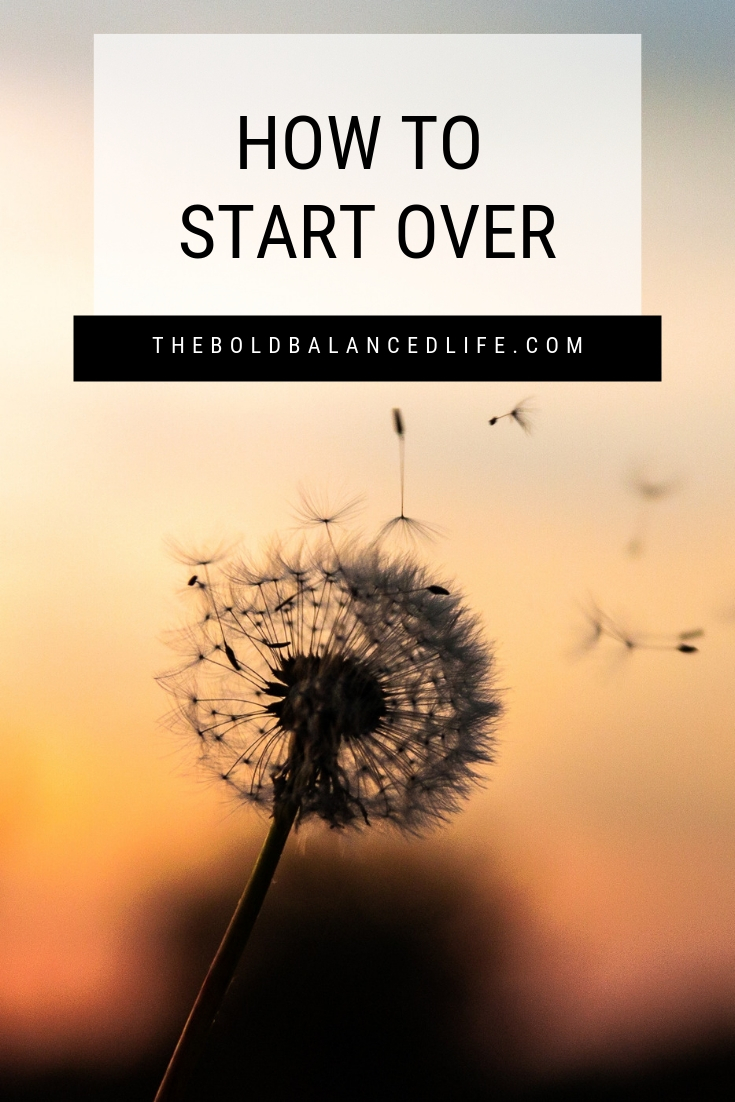I was working on this week’s post about how to reach your goals when two things happened:
1.) my friend asked me if The Bold+Blanced Life has an Instagram account, and
2.) one of my heroes, comedian Lilly Singh, announced that she’s taking a break to focus on her mental health.
Both things reminded me of why I started this project in the first place. Trying and failing to maintain an Instagram account on top of everything else I had going on at the time was what tipped me over the edge. My epic breakdown forced me to take some time off and figure out how to start over.
So today I want to share with you the exact steps I took to get my life back on track:
Step 1: Unleash the beast (a.k.a. admit you have a problem).
This step usually involves a lot of crying and shouting. Go grab your tissues and head somewhere you can have a proper meltdown. Seriously, get it all out! Feel sorry for yourself, curse everyone and everything, punch a wall. Whatever you need to do to release that debilitating pressure.
Step 2: Take stock.
Get a notebook (or whatever you have on hand) and draw a life pie with four equal pieces, or simply write down what your priorities or goals are in the following four areas:
- Self + Care: Things that renew our energy and give us inner peace.
- Work + Goals: Things that increase productivity and bring us closer to realizing our dreams.
- Play + Learn: Things that nurture our inner artist and make us grow as a person.
- Love + Support: Things that improve our relationships with others.
Start with self-care. If you’re reading this post, you’ve likely neglected to prioritize yourself. This step is not only about figuring out what matters most to you, but it’s also going to serve as a roadmap.
Step 3: Do something that makes you happy.
Create a self-care list. Write down 21 things you find relaxing or make you happy. Focus on the little things you can do easily. Pick one thing from your list and do it now. Then try to do one thing from your list every day. This is how I started my mindfulness habit.
Every day for the past 43 days I’ve taken 2-10 minutes to close my eyes and just be present in the now. I honestly can’t remember the last time I’ve felt so at peace. It helped me stay relatively calm and call for help during a recent car accident, despite the other car hitting us where my toddler was sitting.
Make your health and wellbeing a priority—always. It’ll be so much easier to handle stress and bounce back from illness. For me:
- daily mindfulness
- working on correcting my posture
- enduring two uncomfortable dentist visits and
- getting a humidifier
solved nearly all of my health issues in less than a month.
Step 4: Find affirmations and visual reminders that work for you.
I’m a skeptic and not the most spiritual of persons, but this actually works for me. To give you a few ideas, I have reminders taped to the wall next to my bed, at my desk and on the mirror + a Pinterest vision board, and two reminders on my phone.
My standard affirmations:
- Treating myself well will make me stronger.
- I can handle anything that comes my way. / Let go of the outcome.
- Feel the fear and do it anyway.
- Find joy in the journey.
- LISTEN.
My practical reminders:
- A checklist so I’m off to a good start into the day:
– Have a glass of water on my bedside table to drink first thing in the morning.
– Have warm socks and a cozy sweater next to my bed so I actually make it out of bed now that it’s cold in the morning.
– Brush my teeth right after waking up instead of after breakfast (because let’s be real, otherwise I might forget about it until I go to bed). - A habit tracker:
For all the things I’ve prioritized in Step 2, I’ve created a “Have I [insert habit] today?” grid where I can tick off the boxes whenever I’ve done one of the habits. It serves not only as a reminder but also as motivation. If I ticked off all the boxes for one week I give myself a reward. Even though it seems silly, these little successes have done a great deal to help rebuild my confidence.
The two quotes that pertain to my greatest challenges:
- “Dripping water hollows out stone, not through force but through persistence.”—Ovid
- “Perfectionism is a refusal to let yourself move ahead. By focusing on getting the details right, we correct our originality into a uniformity that lacks passion and spontaneity.”—Julia Cameron, The Artist’s Way
I promise you, the silly feeling that comes with this step wears off after a while. Give it a try for at least 21 days before you dismiss this step.
Step 5: Stop comparing yourself to others.
I know this is easier said than done, and I’ve struggled so much with this. But comparing yourself to others is the key to unhappiness. Especially because we have a tendency to compare our behind-the-scenes with everyone else’s highlight reel. And because stopping this habit is so hard, I decided to go on what Julia Cameron calls a “reading deprivation.”
For one week I didn’t read the news, social media, books. No videos and Netflix, either. It was weird the first day, but overall that week was amazing! I was so much happier that I decided to continue staying off of social media for the time being and cut down on everything else.
Sadly, for this step to work for me, I need a constant reminder:
I’m not other people. I go my own way, at my own pace.
I can’t stress enough how important it is to remind yourself that everyone’s circumstances are different. And everyone’s priorities are different. For me, that meant accepting that, for now, I won’t be able to dedicate more than 2-4 hours a day to my dream career. And that’s okay. You can still make progress if you use the time you do have wisely.
Step 6: Get yourself a support system.
In my post, The Most Overlooked Key to Happiness, I talked about how it’s easier to dust yourself off and try again if you know you have a support system of people who have your back.
So the first thing I did was to find someone who could be my accountability partner. I was lucky to find one in my sister, even though she lives on a different continent with a very inconvenient eight-hour time difference. Every week we have a half-hour phone date to talk about how we are doing with our weekly goals and to remind each other to take it one day at a time.
If you don’t have a family member or friend you can rely on, talk to a therapist, life coach, or if you’re religious, your spiritual guide (or whatever you call it). If that doesn’t work for you either, consider joining an online community. I’m hoping to build one myself over the next few months, but one that’s already established and doing well is Lavendaire’s Artist of Life Community.
Journaling
The second thing in my recovery that gives me great support is to write down every day
- how I’m feeling,
- the things that work well and the things that don’t,
- what I wish for,
- and what I’m grateful for.
I set a 15-minute timer and do what’s called Morning Pages. It’s one of the tools in Julia Cameron’s The Artist’s Way, a book I’ve stumbled upon in the library. She also gives a lot of prompts and fun ways to dig for the root of what’s holding us back. But any type of journaling will do. The aim is to clear your mind so you are better able to focus throughout the day, as well as sleep better at night.
Step 7: Take it one day at a time.
You’re likely reading this post because you wanted to be all and have all, going a hundred miles an hour until you hit a wall. If there was one thing I had to learn (and I’m still learning), it’s to slow down and find joy in the journey.
It’s the one sentence that a German therapist once said to me—”Eile mit Weile“—that really stuck with me over the years. Eile mit Weile is a habit that used to be ingrained in German culture; it loosely translates to “more haste, less speed” or one step at a time. Quality over quantity.
Pick one goal or priority from Step 2 and split it up into baby steps (small tasks), so tiny in fact that you can accomplish one task every day. If you ever miss a day, or five, or even 21, that doesn’t mean all is lost. Rachel Aust, author of Less: A Visual Guide to Minimalism has a helpful video on that called How to Stay Motivated. The journey to a bolder, more balanced life begins with aiming for good enough, not perfection.
Bonus Step: Find joy in the journey.
Life is full of roadblocks and detours, so even if you follow all of these 7 steps to a T, it’s not going to be a smooth ride from here on out. And that’s okay because life would be a bore if you reached all your goals at once and stopped growing as a person. Remember that deliberately slowing down isn’t standing still or being lazy. It’s taking time to enjoy the view and celebrate life’s blessings.
At the end of their lives, people tend to have two regrets: not spending enough time with their loved ones, and not doing the things they really wanted to do. I made a promise to myself that I’m not going to be one of those people, and I challenge you to not become one of those people either.
Image: Dawid Zawiła







